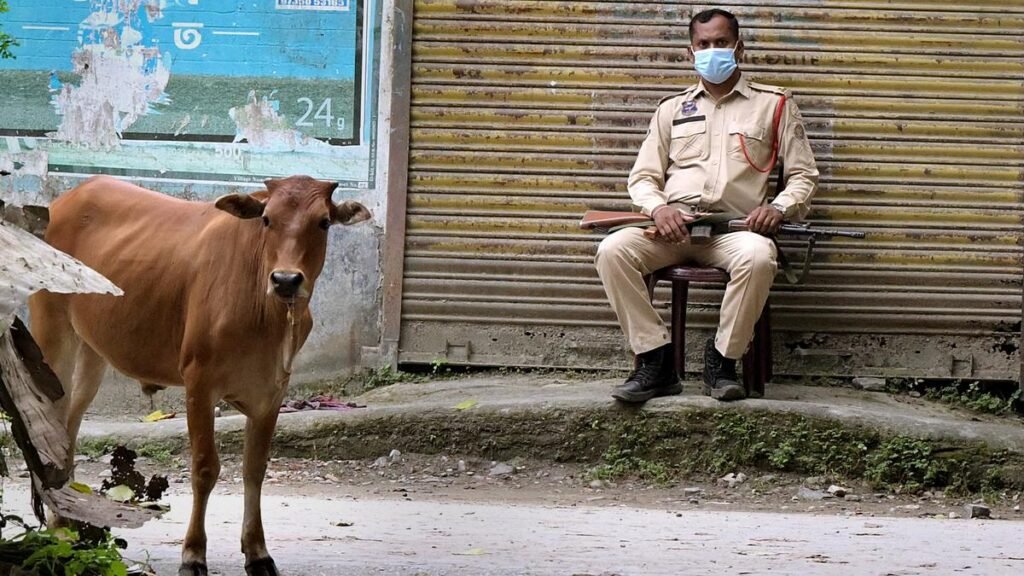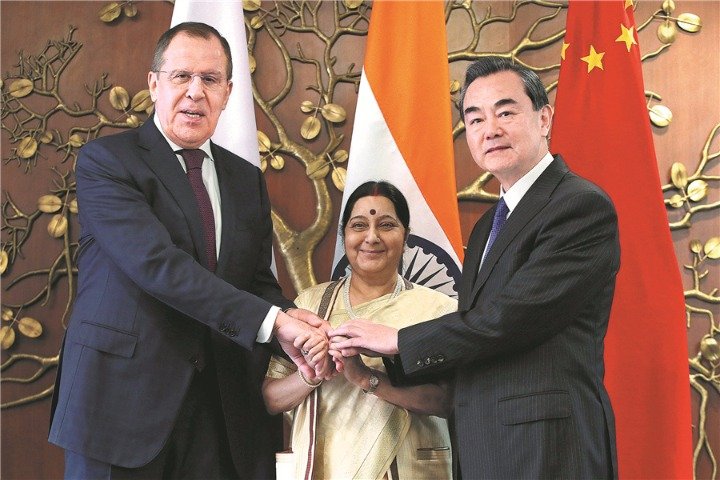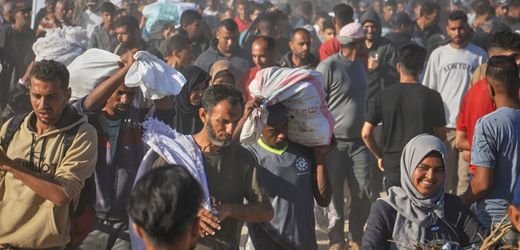
Sobjer Ali is a man of routine. Every day, for nearly 50 years, he has travelled by boat between Kuntirchar Part 2, the village where he lives in Dhubri district of Assam, and Patharghat, where he ran a shop selling cattle feed. The routine, disturbed in the past sometimes by festivals, floods, and communal conflicts, was disrupted on June 14 when his world turned upside down. The shop that sustained Ali’s family of six was one of the 110 deemed illegal and demolished by the local authorities. This happened a week after the body parts of cattle were allegedly found on successive days near a Hanuman temple about 2 kilometres away, triggering anger in the district.
Dhubri, the headquarters of the Muslim-majority Dhubri district, is 290 km west of Guwahati. It is bounded by the Brahmaputra river and its tributary, Gadadhar, on three sides. The town stands close to where the Brahmaputra becomes the Yamuna after flowing past the India-Bangladesh border. Dhubri is also used as a metaphor by some communities and political parties to underline the fear that drives politics in Assam — of how the influx of people from Bangladesh can one day overrun ‘indigenous’ Indians.
“We have endured worse situations, but aage keu pete laathi maarey nai (no one snatched away our sources of livelihood earlier),” said Ali. “We have been paying ₹50 per week to the municipality through a lessee who renews our lease every year. We barely had an hour to salvage our wares before the demolition started.” He said he cannot understand why he was punished for what miscreants did elsewhere in the town.
Over the last few weeks, a string of similar incidents involving cattle have kept Dhubri on edge. On June 10, citing instances of pieces of meat being purportedly thrown in public places after Eid celebrations, Assam Chief Minister Himanta Biswa Sarma alleged that beef is being “weaponised” against Hindus in the State. Stressing that the Assamese people have to take a “non-compromising” stance to push back “illegal foreigners,” Sarma maintained that the State was waging a struggle against forces which had “sympathisers” across the world.
The spark
Patharghat, a ferry point on the bank of the Brahmaputra in Dhubri, is about 200 metres from a park called the Netai Dhubuni Ghat. This was constructed in honour of a washerwoman, Dhubri, from whom the district gets its name. Flanking this park along an 800 m stretch of road are several places of worship that once made Dhubri a religious confluence. These include a Ram temple, a Kali temple, the Panchpeer dargah, the Gurudwara Sri Guru Tegh Bahadur Sahib, and an Armenian church. The offices of the Dhubri District Commissioner and Senior Superintendent of Police are located on the stretch from Patharghat to the Armenian church, which was converted into a ladies’ club years ago.
According to the Chief Minister, around Eid-al-Adha on June 7, “miscreants” scribbled some “provocative” words on the walls of some structures in this high-security zone. He suggested to the media that the words were written by people who belonged to Nobin Bangla, a group that reportedly espoused the merger of Dhubri with Bangladesh. He also said that the “head of a cow” was discovered at the 35-year-old Hanuman temple in the town’s Baluchar Ward No. 3 on June 8, the day after the qurbani (sacrifice) Eid.
The Hanuman temple where miscreants allegedly tried to stir communal tensions.
| Photo Credit:
Rituraj Konwar
The Hanuman temple is situated on about half an acre of land owned by a man named Vishal Agarwal. He works as a distributor of soft drinks for the Dhubri region. Unlike conventional temples, it is a small, rectangular, tin-roofed concrete structure about 6 feet in height.
This plot of land is surrounded by two lanes, a school, and the office of the Seemanta Chetana Mancha, an international-border-areas-specific wing of the Rashtriya Swayamsevak Sangh (RSS). The Dhubri Baluchar Kabarsthan (cemetery) is located across one of the lanes, while an office of the Forest Department is across the other. The temple is also located about 50 m from the Dhubri Magistrate Colony and diagonally across the Iddgah Field, behind which is a Muslim locality.
On the night of June 8, after the alleged sight of the cow’s head sparked tension, the authorities dismantled 12 makeshift shops run by Muslims along the wall of the Iddgah Field after right-wing protesters claimed that they sold beef and other illegal items. The Assam Cattle Preservation Act, 2021, provides for the preservation of cattle by regulating their slaughter, consumption, and transportation in the State.
Agarwal declined to speak on the beef controversy surrounding the temple on his plot. He said that much of the land used to be a jute warehouse until a decade ago. He also said that he had engaged Ramjan Ali Sheikh, the first man to be arrested when pieces of beef were again found on June 9, nearly at the same spot, as a guard, because Sheikh’s uncle used to be the guard earlier.
“My son performed his duty diligently. Like any other day, he came home on the morning of June 9 for breakfast,” said Sheikh’s mother, Amina Begum. “Many policemen were posted in the area around the temple from the night before. In the morning, the police summoned my son as they suspected him of having placed the beef in the temple. He has been in lock-up since.” Hers is one of the seven Muslim families in the Hindu-majority Baluchar locality.
According to Masud Zaman, an advocate associated with the Badruddin Ajmal-led All India United Democratic Front (AIUDF), the discovery of cattle body parts for the second time despite watertight security reflected a possible design to let the situation get out of hand.

“The police picked up 18 people randomly without going after the real culprits behind the incident. Some of us stayed at the police station until 2.30 in the morning on June 10 to get some of these people released. They included a minor boy, a kidney patient, a government employee on hospital duty, and a man with a terminally ill daughter,” he said. Among at least 50 others arrested over the next few days was Noor Islam Haque of Gaspara village, known to beg and sleep on the streets in the administrative hub of Dhubri.
The Hanuman temple in Dhubri town of Assam.
| Photo Credit:
Rituraj Konwar
Zaman said that the local authorities handled the situation well after the first incident on June 8. A committee comprising members of the Seemanta Chetana Mancha, Muslims, and members of other organisations decided that they would maintain peace at any cost.
“After the second incident took place on June 9, schools were closed on June 10. But everything was normal from the next day,” he said. “Then the Chief Minister arrived on June 13 and said that he would issue an order to shoot on sight those who were pelting stones. This gave the impression that there is total unrest in Dhubri.”
A string of incidents
From June 14, incidents similar to those at the Dhubri temple were reported elsewhere in Assam. The Chief Minister posted on X that beef was allegedly thrown near a Kali temple at Lakhipur in the adjoining Goalpara distric; the head of a cow was allegedly found at Borpukhuri in central Assam’s Hojai for the second time in less than a week; and skulls of cows were allegedly discarded near a namghar, a neo-Vaishnavite prayer hall, in north-eastern Assam’s Lakhimpur district. The police arrested more than a dozen people in connection with these incidents.
Piklu Paul, the vice-president of the Dhubri unit of the Bharatiya Janata Party (BJP), said that the Hindus in the district have always lived under pressure. In the aftermath of the Babri Masjid demolition in 1992, up to 14 people were killed and curfew was imposed for more than a month. There was relatively less violence in 2012 as a fallout of the Bodo tribal-Muslim conflict in the adjoining Bodoland Territorial Region. “We are grateful to the Chief Minister for shoot-at-sight orders, which have kept the miscreants indoors after dusk. Dhubri could have burned had this tough step not been taken,” he said.
Senior Congress leader Rakibul Hussain, who ended the AIUDF’s 15-year run in the Dhubri Lok Sabha constituency in 2024, chose to stay out of the controversy. But Kazi Mahmudul, a local Congress leader, was ready to speak. “We have no complaints if those responsible for such a heinous act are punished according to the law, but carrying out demolition drives ostensibly linked to the Hanuman temple incident is painful,” he said. “The government has the right to evict people from the land it owns, but there is a process to be followed. One has to give time to people who have been living in certain areas for decades.”
Other party leaders said no “true Muslim” would place beef near a place of worship of people belonging to another religion.
The drive has hit Jaharuddin, a Dhubri resident, who pulled a handcart to deliver goods from Patharghat to dealers across the town. “The government should be lenient with demolitions so that we survive,” he said.
Cattle smuggling
Dhubri residents believe that an application filed by the Dhubri Iddgah Committee to the district authorities, seeking to bring in about 4,000 cattle for qurbani (sacrifice) on Eid, was the genesis of the trouble. The committee issued ‘membership cards’, valid up to June 7, to procure the cattle.
“But the number of cattle brought in from West Bengal via Boxirhat (town bordering Assam) from June 3-5 was some 4 lakh,” a member of the Seemanta Chetana Mancha said. “This caused a traffic jam on the highway. Thousands of people, each with a bull or cow on a leash, were walking along the road as if they were enjoying some kind of patronage. They paraded through Hindu areas, hurting the sentiments of many.”
After local Hindus raised a hue and cry about the cattle passing through a security cordon along the inter-State border easily, and in violation of the Assam Cattle Preservation Act, the government took steps to check the inflow. But these measures had a minimal effect.
During his visit to Dhubri, Chief Minister Sarma said that a new network of cattle smugglers had increased its activities over the last few months and was bringing in cattle in large numbers from West Bengal. He vowed to crack down on this ‘network’ while asserting the government’s commitment to enforcing law and order and defeating all communal forces.
Both Hindus and Muslims, however, have started doubting the government’s intention. Zaman said that the authorities “showed a tendency to arrest petty criminals” for the Hanuman temple incident and not those who allegedly violated the cattle transportation law. The district is notorious for cattle smuggling to Bangladesh, where a cow fetches twice the average price of ₹30,000 in Assam. Some residents allege that the smugglers operate in nexus with a section of the district officials and the police, who, according to them, get a cut of up to 10%.
Dhubri’s Senior Superintendent of Police, Leena Doley, dismissed allegations that the police were refusing to arrest illegal cattle traders. “We have rounded up a few, and the process is ongoing,” she said. She replaced Navin Singh, who was transferred out of Dhubri a week after the incident at the Hanuman temple. As many as 164 police personnel, including 34 sub-inspectors, were also transferred out of the district.
“The message has gone out that the government will not tolerate disturbance of any kind. The situation is totally under control now,” District Commissioner Dibakar Nath said.
Uneasy neighbours
Local BJP leaders blamed the Congress for keeping the district on edge. They said that the Congress had fuelled riots after the Babri Masjid demolition and had also let the situation deteriorate in 2012. They also said that it was not a coincidence that the incident at the Hanuman temple had happened a year after the Congress wrested the Dhubri parliamentary seat from the AIUDF.
Congress leaders, on the other hand, said that they were not surprised by the BJP’s bid to project the AIUDF as a more secular party, as it was the “B-team” of the saffron brigade. Referring to the Dhubri incident, State Congress president Gaurav Gogoi said that the RSS and its affiliates, including the BJP, were fanning communal sentiments ahead of the 2026 Assembly elections. “Investigations should be carried out against all those arrested for placing beef and parts of a cow in public places, including religious institutions, but those who put such ideas in the minds of miscreants should be probed too. Such incidents are part of the pre-election strategy of the BJP-RSS to hide their failures,” he said.
Chief Minister Sarma retaliated, asking Gogoi to submit proof before accusing Hindus of fomenting trouble. “If Hindus have to throw meat, they will throw pork, not beef,” he said.
At Baluchar, the seeds of distrust between Hindus and Muslims, sown years ago, seem to have sprouted. Paresh Das, a trader, said, “This was not the first time that go-mangsho (beef) was placed near the Hanuman temple. We know it will not be the last time, either. As the minority community, we have to tolerate this. We just hope that our sentiments are respected.”
“Dhubri has not been an example of communal harmony, but economic compulsions often forced the people to apply the brakes after briefly attacking each other,” said 83-year-old Md Abdul Sattar Mollah, a former employee of a match factory. “I was drawn into riots when I was young. Thankfully, no one got killed this time. But the cold stares and animosity in the eyes of people now is worse than death.”
rahul.karmakar@thehindu.co.in





